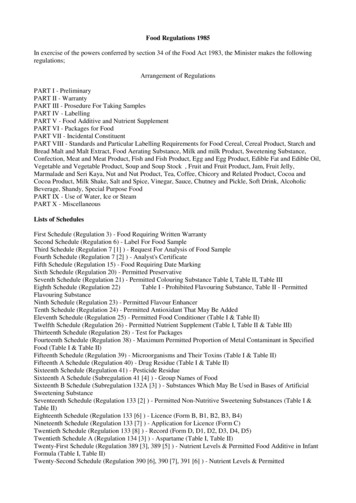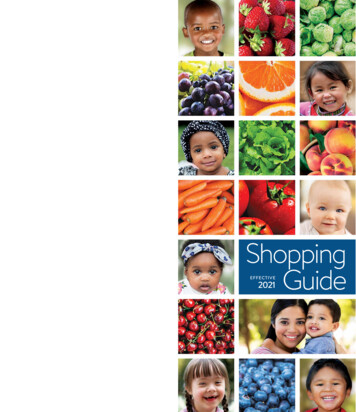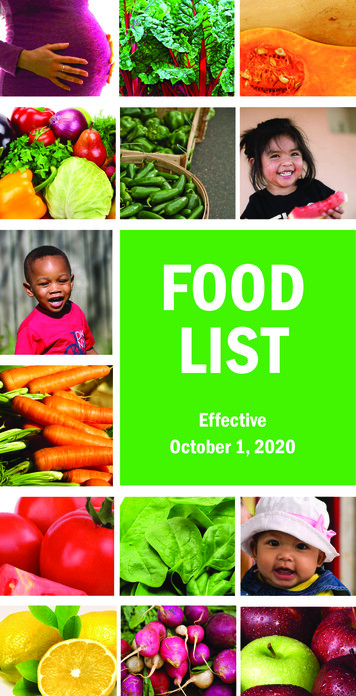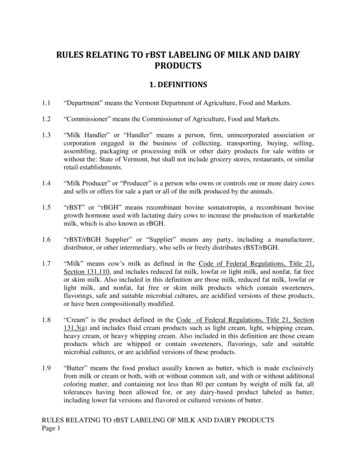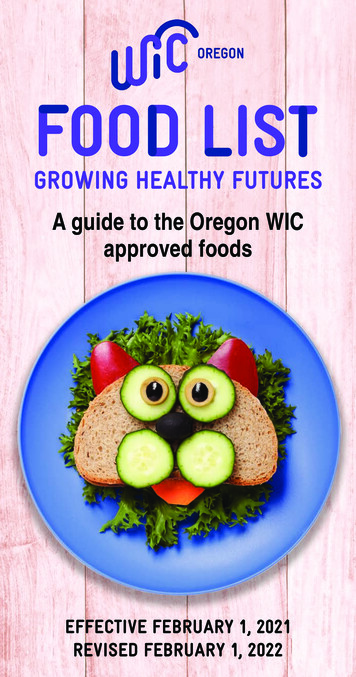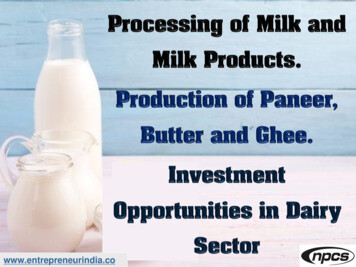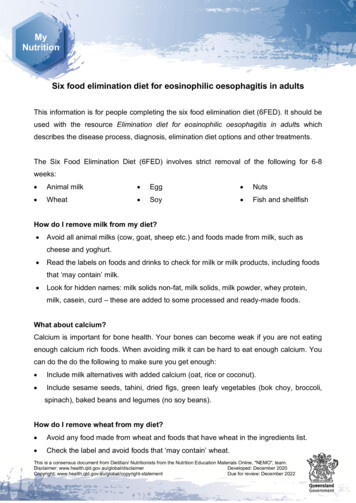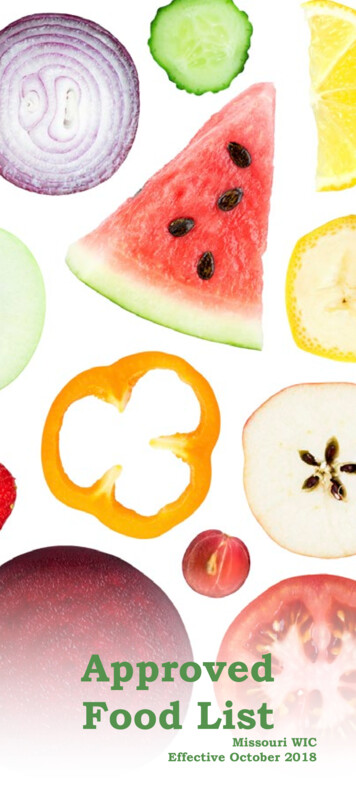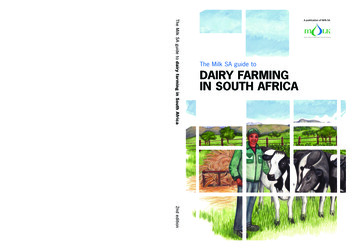
Transcription
The Milk SA guide to dairy farming in South AfricaPublished byThe Milk SA guide toDAIRY FARMINGIN SOUTH AFRICA2nd editionA publication of Milk SAA publication of Milk SAISBN: 978-0-9922220-6-2AA - COVER.indd 12014/06/06 3:24 PM
The Milk SA guide toDAIRY FARMINGIN SOUTH AFRICAA publication of Milk SAPublished byTHIS IS A FREE PUBLICATION AND IS NOT FOR SALE BY ANY PARTY, INSTITUTION ORORGANISATION WITHOUT PRIOR ARRANGEMENT AND CONSENT OF MILK SA. PLEASEREPORT ANY IRREGULARITIES IN THIS REGARD TO MILK SA ON TEL 012 460 7312AA- PG001-005 INTRO PAGES.indd 32014/06/06 3:24 PM
Copyright 2009, 2013 – Milk SA (NPC)PO Box 1961Brooklyn Square, 0075South AfricaTel 27 (0)12 460 7312www.milksa.co.zaSecond edition, second print, 2014ISBN: 978-0-9922220-6-2All rights reserved.No part of this book may be reproduced or transmitted in any form or by any means, electronic or mechanical, including photocopying and recording, or by any other information storage or retrieval system, withoutthe written permission from the copyright holder.Managing DirectorPublisherExecutive editorContent compilerContent evaluatorIllustratorSubeditorCreative designReproductionErika AlbertsLeza PutterHelene Pheiffer – Institute of Dairy Technology (NPC)Carien HavengaProf Dirk LourensRonelle OosthuizenMichele van LoggerenbergSulizna BothaAgri Connect (Pty) LtdPO Box 1284Pretoria, 0001South Africawww.agriconnect.co.zaPrinted and bound by CTP Printers, Cape TownAA- PG001-005 INTRO PAGES.indd 42014/06/09 11:29 AM
Message fromMILK SADear readerMilk is an essential part of many farming enterprises, big and small. For commercial farmers milkis an important source of income, while for many smaller farmers it mainly serves to feed thehousehold and to generate an additional income. Whatever the case may be, milk needs to be ofthe best quality possible.This publication is an introduction to the best practices and basic principles of running a dairyparlour. However, it is by no means the complete authority on what it takes to be a successful milkproducer.Milk South Africa trusts that this book and its contents will contribute to the promotion of our dairyindustry and more particularly, to support our new dairy entrepreneurs in becoming successfulpartners of the industry.May you find pleasure and value in working through this publication!Regards,The Board of DirectorsMilk South AfricaAA- PG001-005 INTRO PAGES.indd 52014/06/06 3:24 PM
CONTENTSPageCHAPTER 1 THE SOUTH AFRICAN DAIRY FARMING ENVIRONMENT1.1ABCDIntroduction to the South African dairy industryCommercial and non-commercial dairy farmersDairy industry value chainOpportunities and risks in dairy farmingBuying a dairy farm13141618191.2ABCEconomy of dairy farmingPrepare a budgetUnderstand the dairy marketSell your milk2022241.3ABCDBuying cattle for dairy farmingVarious breeds of cattleFactors to consider when buying cattleSelection criteria for cattleBiosecurity principles on a dairy farm26303234CHAPTER 2 DAIRY CALF AND HEIFER REARING, FEEDING AND HEALTH CARE2.1ABCDDairy calf and heifer health careDevelopment phases from a calf to a cowThe five Cs of calf careSigns of a healthy calfVaccination programmes of dairy calves and heifers394042442.2ABCDCalf-rearing systemsBiosecurity of calf-rearing facilitiesPermanent housing and movable calf pensDeep litter systemsCalf camps for group-rearing after weaning464850512.3 Hygiene and careAImportance of hygiene52viAA- PG006-012 CONTENTS.indd 62014/06/06 3:25 PM
BCDFactors affecting hygiene and signs of poor hygieneFly controlPersonal hygiene and protective clothing5354562.4ABCCalf feedingHandling and feeding of colostrumNutritional requirements at various agesWeaning a calf5862642.5ABCDDairy calf diseasesDiarrhoeaSalmonellosisColibacillosis (white scours)Other diseases666870712.6ABCDEFCalf and heifer careCalf and heifer handling and restrainingIdentification, marking and brandingRemoval of accessory teatsDehorn your dairy calvesCastration of bull calvesCare for your heifers747681828486CHAPTER 3 DAIRY ANIMAL HEALTH CARE3.1ABCBasic anatomy of the dairy cowDigestive systemReproductive tractThe udder3.2ABCDGeneral dairy livestock healthSigns of a healthy dairy animalFactors affecting dairy animal healthImmunisation of livestockHandling of vaccines889092949798100viiAA- PG006-012 CONTENTS.indd 72014/06/06 3:25 PM
CONTENTSPageEFGHIHoof healthFootbathsFootrotPoisoning in dairy animalsWounds and abscesses3.3 Diseases in dairy animalsATypes of diseasesBExternal parasites: tick-borne diseases Gall sickness (Anaplasmosis) Redwater (Babesiosis) HeartwaterCInternal parasitesDBovine infectious diseases Anthrax (miltsiekte) Brucellosis Blackquarter (sponssiekte) Botulism (lamsiekte) Tuberculosis (TB) Salmonellosis Colibacillosis (E. coli) Lumpy skin disease (knopvelsiekte) Rift Valley fever (slenkdalkoors) Three-day stiffsickness Malignant catarrhal fever (snotsiekte) Bovine virus diarrhoea (BVD)and mucosal disease (MD)EMetabolic diseases Milk fever in cows Rumen acidosis (suurpens) Ketosis 130132134136138140142144146148150151152viiiAA- PG006-012 CONTENTS.indd 82014/06/06 3:25 PM
3.4ABCDEDairy cow healthBasic udder careTeat dippingMastitisHow to use CMCTDry cow management154156158162164CHAPTER 4 DAIRY ANIMAL PRODUCTION4.1ABCDEDairy animal herding and handling practicesAnimal welfareHandling facilitiesHandling of cattle on a public roadTransport of cattleProper handling of dairy animals1661671681701724.2ABCDairy animal breeding conceptsReproduction planning and goalsBreeding seasonsInfertility in a dairy herd1731741754.3ABCDEFBreeding practicesNatural breedingArtificial insemination (AI)Gestation in cowsBirth and after-birth processHerd compositionCondition assessment (scoring)1761771781811821851864.4 Water supply systems and fencing on a dairy farmAWaterBFencing188190ixAA- PG006-012 CONTENTS.indd 92014/06/06 3:25 PM
CONTENTSPageCHAPTER 5 DAIRY LIVESTOCK FEEDING5.1ABCDEFGHIJDairy feed typesBasics of cow nutritionHay cropsMaking hayBuilding a hay rackSilage cropsMaking silageConstructing a bunker siloPasture cropsNatural grazingSupplementary feeding and licks1941961992002022042052072102115.2ABCFeeding practicesHeifersCows in milkDry cows2142152155.3ABCFeeding facilities and equipmentFeed storage facilitiesFeed troughsDrinking systems and water quality216216217CHAPTER 6 MILK HARVESTING AND IN-PARLOUR PROCESSING6.1ABCDMilk harvesting facilitiesA basic milking shedLayout of milking parloursHolding pens and walkwaysMoving dairy animals to and from the parlour218221228228xAA- PG006-012 CONTENTS.indd 102014/06/06 3:25 PM
6.2ABCDEMilk harvesting processGood milking practicesPre-milking preparation of a cowWays to milk a cowPost-milking cow careHandling of contaminated milk2292312352422446.3 Dairy parlour equipmentAMilking equipmentBOther equipment2462506.4ABC252254260Dairy parlour hygienePersonal hygieneParlour and equipment hygieneSafe handling of chemicals6.5 Record keepingAMilk collection recordsBOther records2622646.6 Composition of milk and quality indicators2686.7ABCDE270272274276278In-parlour processing and quality controlCold chain requirements and bulk tank managementImportant processesHygiene in the processing environmentBasic milk testingOther testing methodsRecommended additional reading280xiAA- PG006-012 CONTENTS.indd 112014/06/06 3:25 PM
AA- PG006-012 CONTENTS.indd 122014/06/06 3:25 PM
Chapter 1 The South African dairy farming environment1.1Introduction to the SouthAfrican dairy industryMilk production is an essential part of many farming enterprises. In South Africa it is thefifth largest agricultural industry. Milk is produced every day and gives a regular incometo the numerous small and large producers. Milk production is very labour-intensiveand provides employment to many people. Highly sophisticated equipment is used formilking and therefore skilled and well-trained workers are essential. Great commitmentis needed because cows must be milked at least twice a day, throughout the year.Although there are fewer dairy farmers in South Africa than before, they still produce wellbecause they have enlarged their herds and use the most advanced technology. They understandthat dairy farming is a business and needs to be operated with the relevant business skills.Knowledge of dairy cattle and their management is necessary, as well as providing the cow inmilk with the kind of nutrition that will allow it to produce the optimum amount of quality milk.Milk can be used to make an enormous variety of high-quality products. The high cost ofmilk as a raw material has demanded a high-technology processing industry. Strict and wideranging quality regulation and high transport costs can be expected because of milk beingperishable and bulky.FARMING BUSINESS13AA- PG013-038 CHAPTER 1.indd 132014/06/06 3:26 PM
The Milk SA guide to dairy farming in South AfricaA. Commercial and noncommercial dairy farmersCommercial dairy farmersCommercial farming is when the main purpose is to sell and/or add value to agriculturalproducts, such as milk, for profit. Choices about what or how much to produce are determinedby the market, not by the needs of the farmers and their families. The scale of operations islarge, the milk is produced in large quantities and is sold in bulk to large dairy processors,and sold for export purposes as well.With commercial dairy farming one has to keep in mind that success in the dairy marketdepends on various factors. Commercial dairy farming is not simply “a way of life”; it is abusiness, and without the relevant business skills, a dairy enterprise cannot be sustainable.Non-commercial dairy farmersA non-commercial dairy farmer, being an emerging, small-scale, communal or subsistencefarmer, is a producer who cannot produce milk to the market on a continuous basis. Tobecome a successful dairy farmer, it requires hard work and you have to develop severaltechnical and managerial skills.Although the Department of Agriculture, Forestry and Fisheries (DAFF) and Milk SA havealready spent a great deal of effort on empowering emerging dairy farmers, there are stillvarious challenges. Emerging farmers can no longer start with only 5 cows in their backyards as a sustainabledairy farm now needs at least about 100 cows to survive and start being profitable. The high intensity of milk production and risk factors such as milk quality and safety aremajor barriers to entry for emerging farmers. Dairy farming requires specialised knowledge in numerous disciplines such as animalhealth, feeding, calf rearing, etc. Therefore, besides sufficient financial resources, noncommercial dairy farmers also need access to mentorship and training.Communal/subsistence farming is when the main purpose of the farmer is to produce foodand other agricultural products, such as milk, to meet the needs of the farming family. Themilk can also be traded with others for products that are not grown or made on the farm.Very little money is spent or earned in a subsistence farming enterprise, and the purpose isnot to become a commercial dairy farmer.When the produced milk is consumed or used by an individual farmer or his family, or sold orexchanged amongst a small group, it is known as subsistence or communal dairy farming.Milking one’s own cows provides a cheap source of high-quality food for the home, and familiesalso benefit from a better diet if milk is included.14AA- PG013-038 CHAPTER 1.indd 142014/06/06 3:26 PM
Chapter 1 The South African dairy farming environmentExcess milk (after satisfying the requirements of the home) can be sold to neighbours orpassers-by. The sale of milk can result in a useful income. Milking a few cows by hand will notrequire any additional labour. The number of cows kept will depend largely on the available feedas well as on the number of cows the farmer can milk by hand.Commercial dairy farmersEmerging dairy farmersSubsistence dairy farmers15AA- PG013-038 CHAPTER 1.indd 152014/06/06 3:26 PM
The Milk SA guide to dairy farming in South AfricaB. Dairy industry value chainMilk production in South Africa is dominated by two types of producers: large-scalecommercial producers, and small to medium-sized commercial producers.INPUTSPRODUCER (DAIRY FARMER)DIRECT INPUTSSeedFertiliserWaterFeedElectricityAnimal health productsFarming/dairy equipmentINFRASTRUCTURE/CAPITAL INVESTMENTDairy cattleMilking parlourMilking machinesCooling facilitiesSilage bunkersHousing/shedsFencingIrrigation systemWorkersSUPPORT INPUTSFinanceAnimal health, production andreproduction info and technologyTrainingConsumer16AA- PG013-038 CHAPTER 1.indd 162014/06/06 3:26 PM
Chapter 1 The South African dairy farming environmentLarge-scale commercial producers sell milk to dairy processors. Small and medium-sizedproducers sell most of their milk directly to consumers and/or to processors. Dairy processorsbuy milk from producers to produce dairy products for distribution to retailers, exports and forfurther processing.MILK BUYERPROCESSINGTransport, infrastructure,bulk tanking equipmentFluid products: pasteurised milk, yoghurt,buttermilk, amazi, etc.Concentrated products: cheese, milkpowder, condensed milk, etc.RETAILAND sConsumer17AA- PG013-038 CHAPTER 1.indd 172014/06/06 3:26 PM
The Milk SA guide to dairy farming in South AfricaC. Opportunities and risks indairy farmingIt is generally accepted that success in thedairy market depends onvarious factors, including: quality products sound management transparent industry informationSince deregulation (1997) the number of smaller milk producers havedeclined, mainly because marketing/control boards no longer offered a supporting role to milk producers,and production and marketingbecame more competitive. Dueto economies of scale, processors have amended their procurement patterns after deregulation and startedbuying less from smaller milk producers.Some consumers like to buy fresh milk directly from producers, because the source of themilk, its quality and safety is known. Producers can also sell directly to small cafés andstreet vendors. In this way, some transaction costs can be cut and it will lead to higherprofits. A sound relationship needs to be in place between the sellers and the buyers.The high demand for value-added products, such as sour milk, yoghurt and cheese, isanother market to be explored. However, to go this route would require high investment,market knowledge and the necessary training.Within the dairy farming industry, there are many sources of uncertainty and risk.These include: Uncertain weather conditions that have an influence on the herd and the production ofsufficient volumes of feed. Uncertain product prices or uncertain interest rates. Uncertainty with respect to market availability for products. Uncertainty about possible changes in regulations of governing production practices. Uncertainty about government policy to allow more imports, which can drive down localprices. Sudden outbreaks of contagious diseases.However, a successful farmer can reduce the risks by proper planning and good management.18AA- PG013-038 CHAPTER 1.indd 182014/06/06 3:26 PM
Chapter 1 The South African dairy farming environmentD. Buying a dairy farmBuying a dairy farm is not a decision you should make without talking to many expertsand considering various factors, because it involves investing a huge amount of money.Not only do you need enough money to buy the farm, you will also need money tomaintain the dairy farming activities and furthermore to develop the farm in future.People such as the neighbours, the veterinarian, the extension officer and the agriculturalexpert from your bank can give valuable information and advice. Ask for written records toprove claims about the positive features of the farm.You should find out more about the following important factors: Availability of dependable electricity. Existing milk facilities and equipment. Distance of the farm to the nearest town. Existing milk route of milk-buying companies. Condition of the roads to the farm. Existing contract with a company that buys milk. Availability of sufficient water. Possibility of producing enough roughage. Existing pastures and types of soil.19AA- PG013-038 CHAPTER 1.indd 192014/06/06 3:26 PM
The Milk SA guide to dairy farming in South Africa1.2Economy of dairy farmingA. Prepare a budgetYou can draw up a monthly budget in five simple steps. If you have a personal incomeand an income from your farm, rather draw up a separate budget for each.Step 1: Income“Net income” means the amount of money that you take home after you have paid taxes andlevies. Work out your net income by adding up all of your and your family’s sources of income.Step 2: Fixed paymentsFixed payments are payments that you make every month. This may be an instalment onfurniture, feed for your cow or school fees, and includes other things such as teat dip orvaccinations for your cows. Money set aside for savings is also a fixed payment.Step 3: Day-to-day expensesDay-to-day expenses are often not planned for and include money spent on veterinary services,phone calls, cooldrinks and groceries.Step 4: Luxury paymentsThis is also known as non-essential payments. These are the things that you DO NOT have tospend any money on, for example beer and sweets. List these things, especially those thingsthat you like to buy but cannot really afford.Step 5: Personal budgetUse a blank page and put your total income right at the top. List your fixed payments, dayto-day expenses and luxury items. Add these three totals together to give you a total forexpenses. Subtract your total expenses from your total income. The difference is what youhave left every month. If the difference is a minus, you will have to look at reducing the amountthat you spend or increasing your income. If you have money left, consider saving up a biggeramount for something that you really want to do, such as expanding your dairy.Borrowing money Never borrow money if you do not have to. Borrow only for necessities. Pay the borrowed money back in instalments and do not miss a payment.20AA- PG013-038 CHAPTER 1.indd 202014/06/06 3:26 PM
Chapter 1 The South African dairy farming environment Net income is all your andyour family's sources ofincome. Fixed payments arethe things you have topay for every month. Day-to-day expenses are notalways planned for. Luxury payments are spenton things that you don’t reallyneed. Do your budget on paper. Work out how much money youhave left by subtracting all yourexpenses from your income.21AA- PG013-038 CHAPTER 1.indd 212014/06/06 3:26 PM
The Milk SA guide to dairy farming in South AfricaB. Understand the dairy marketBefore you can sell your milk, it is necessary that you understand some basic marketprinciples. Once you understand these principles, you will be able to expand yourmilk sales with confidence.The production of milk follows a process that basically consists of four steps: Rearing animals (feeding, breeding and caring for them). Producing (milking your cows). Collecting, chilling and bulking (transporting your milk to the collection centre or to yourcustomers or collection of milk on your farm). Marketing (the sale of your milk, directly to the public or to a buyer or cooperative).Milk priceThe price that you receive for your milk is known as the producer price. The price increases asit goes from the producer to the processor, collection centre or cooperative, wholesaler andultimately, the consumer.ProfitProfit is the money that you make from your milk. Profit is the difference between the cost ofproducing and transporting your milk, i.e. feed cost, animal health care, labour, etc, and themoney from the milk sales.CompetitorsThese are the other milk producers who also sell their milk in your region, and often to thesame customers. Too many producers (competitors) in the market can put pressure on the milkprice. Therefore it is good to become a member of a producer group or to join a cooperative.MarketingMarketing is a process that you follow to make people aware of your milk. You can market yourmilk by advertising. Ensure that your milk is of good quality. Creating a good reputation for yourproduct will help ensure that your milk is always sold.22AA- PG013-038 CHAPTER 1.indd 222014/06/06 3:26 PM
Chapter 1 The South African dairy farming environment Rearing: Feed and care for your animals. Marketing: Sell your milk to a buyer,cooperative or shop. Production: Milk your cow. Transportation: Milk collection anddelivery play a very important role inmaintaining the cold chain. Competition is good. Join a group to protect your interests. Profit is the money that you make from your milk.23AA- PG013-038 CHAPTER 1.indd 232014/06/06 3:26 PM
The Milk SA guide to dairy farming in South AfricaC. Sell your milkSelling your milk means that you can earn extra income for your farm, but before youstart selling, there are some important things that you have to consider. Make sure that there is a cooperative, shop, school, processor or even clinic that will buy yourmilk. In other words – list your possible customers. Find out what kind of packaging your customer would prefer. Some might wish for milk to bedelivered in plastic bottles, while others may have their own containers and will only requiredelivery in a can. Be sure that you are equipped to deliver the milk. The shop or collection centre should not betoo far from your farm. Be sure that you are able to deliver cool milk. Your customer will not want warm milk that willgo sour quickly. If a buyer or processor collects milk from your farm, make sure that your access roads aregood and your reception area is up to standard.TestingOnce you start selling your milk to a collection centre, you will have to agree to the testingof your milk. A centre will not buy milk if they are not sure that the milk is hygienic. If you areselling to a shop or to the community, it is your duty to supply safe, clean, fresh and hygienicmilk.Your own abilities Do your own market research. Determine who your clients are. Can you deliver the milk? Can you cool the milk?24AA- PG013-038 CHAPTER 1.indd 242014/06/06 3:26 PM
Chapter 1 The South African dairy farming environmentQuality Find out what type of packaging yourclients prefer. Sanitise and clean all the bottles andcontainers that you use.Marketing Advertising isthe best way tomarket your milk.Records Keep good record of your finances.25AA- PG013-038 CHAPTER 1.indd 252014/06/06 3:26 PM
The Milk SA guide to dairy farming in South Africa1.3Buying cattle for dairyfarmingA. Various breeds of cattleIn South Africa at least seven breeds of cattle are recognised as being "dairy breeds".These breeds are known for higher milk production and are suited to intensive milkproduction systems, such as parlour equipment, cow housing and concentratefeeding. These are Holstein-Friesian, Jersey, Guernsey, Ayrshire, SA Dairy-Swiss,Brown Swiss and Dairy Shorthorn. Other breeds, such as Simmenthaler, Flechviehand South Devon, are occasionally seen in the milking parlour.Choosing a dairy breed can be a difficult decision. However, if you know which breed suits yourneeds, you will be able to choose and buy the right breed.HolsteinThe Holstein is the most popular dairy breed across the world and in South Africa. It is whiteand black in colour and is a big animal (large-framed). These animals are exceptionally highmilk producers and can be culled and marketed as meat. The Holstein sometimes has difficultycalving and is not suited for walking long distances. Its milk has a low butterfat content.Holsteins are not as heat-resistant as some other dairy breeds.JerseyJerseys are smaller than other dairy breeds and are very popular in South Africa. They are lightbrown in colour and are known for their good udders and calving ease. Their milk has a highbutterfat and protein content. Jerseys adapt well to warmer areas. Because of their smallersize, they eat less and are good grazers.AyrshireThe Ayrshire is slightly smaller than the Holstein and can also be culled for meat. It is white andred-brown, and produces milk that has a high butterfat content. Its milk is especially suited asdrinking milk. Ayrshires can function in cold and warm climates. It is known for its good udder.GuernseyThe Guernsey is light red-brown and white. It calves with ease and its milk also has a high26AA- PG013-038 CHAPTER 1.indd 262014/06/06 3:26 PM
Chapter 1 The South African dairy farming environmentbutterfat content. The Guernsey is slightly larger than a Jersey, but smaller than a Holstein. TheGuernsey adapts well to almost any climate and is known for its good temperament and wellattached udder.Dairy SwissThe Dairy Swiss can adapt to different climates and is known forits good fertility and high life expectancy. It also calves easily andproduces milk with a high protein content. Its milk is especiallysuited for cheese production. The Dairy Swiss is a large animal andits coat has various shades of brown, with a white muzzle and ears.JerseyHolsteinAyrshireGuernseyDairy Swiss27AA- PG013-038 CHAPTER 1.indd 272014/06/06 3:26 PM
The Milk SA guide to dairy farming in South AfricaSwedish RedThe Swedish Red is red-brown with white markings. It is a medium-sized, high-producing animaland its milk has a high fat and protein content. The Swedish Red adapts well to both hotand cold climates. It is known for its high production figures, low somatic cell counts andprofitability.Swedish RedDual-purpose breedsThe dual-purpose breeds look like the beef breeds in shape – heavy, short-legged and fairlywide – but produce more milk with a higher butterfat content than typical beef cattle.The common breeds of dual-purpose cattle in South Africa are the following: Devon, DairyShorthorn, Brown-Swiss and Simmenthaler.Dual-purpose breeds are good for milk and meat production. Milk production is lower than withthe specialised dairy breeds. Feeding and management requirements for dual-purpose breedsare lower.Cross-breedsA cross-breed usually refers to an animal with pure-bred parents of two different breeds.In certain pasture-based production systems, farmers prefer smaller cows with lower feedrequirements. For this purpose they use Jersey-Holstein cross-breed cows.28AA- PG013-038 CHAPTER 1.indd 282014/06/06 3:26 PM
Chapter 1 The South African dairy farming rsey-Holstein cross-breed29AA- PG013-038 CHAPTER 1.indd 292014/06/06 3:26 PM
The Milk SA guide to dairy farming in South AfricaB. Factors to consider whenbuying cattleWhen you decide to buy cattle for your dairy farm, you have to choose the rightbreed to farm with. There are many dairy breeds available, but choosing one willdepend on your needs.Economy: Choose a breed that will give you the income and profit that you need. Base yourchoice on three very important things: the highest quality milk; the highest quantity of milk(high production); the lowest possible cost.Area: Choose a breed that is available in your area. If you have to transport your cattle overa long distance, it can cost you a lot of money. Transporting animals can also cause injury.Climate: Some breeds perform best in hot areas, while others perform better in coolerareas.Feeding: Before buying cattle, be sure of the feeding system that you can provide for yourcattle. Some farms are suitable for zero grazing systems, while others are more suitable forgrazing systems. Some breeds are more suited to grazing than others.Volume: Decide whether you want to produce a large amount of milk (high volume), orwhether you would prefer milk with a higher butterfat or protein content. These factors arevery important when you start selling milk to a milk buyer. Some buyers prefer milk with ahigh butterfat content, as this milk is used to make cheese and other dairy products.Learn from your neighbour: If other farmers are farming successfully with a certain breedof cattle in your area, then you should probably follow their example. Do not try to farm witha breed that has not been proven successful in your vicinity.Heifers or cows?If you decide to buy heifers, always buy from a good breeder who will give you all theinformation you will need. Ask for the records and milk production figures. Buy only healthyanimals that are certified as TB- or brucellosis-free. Your heifers should replace your oldcows, so buy accordingly.Heifers are easier to transport and adapt to their new environment quickly. They are usuallyalso cheaper than cows, but produce less milk during their first lactation.By buying a cow that adapts to your farm quickly, you will be sure of a good income becausethe cow will start producing immediately. However, older cows may have mastitis anddamaged teats. Take great care when buying an older cow.30AA- PG013-038 CHAPTER 1.indd 302014/06/06 3:26 PM
Chapter 1 The South African dairy farming environment Talk to your successfulneighbouring farmer foradvice.31AA- PG013-038 CHAPTER 1.indd 312014/06/06 3:26 PM
The Milk SA guide to dairy farming in South AfricaC. Selection criteria for cattleNow that you know what to look for and which breed will suit your farm best, it is time tochoose the cows or heifers that you want to buy. This process is called selection and isdone by looking at six basic factors. These factors all determine the “dairyness” of a milkcow – in other words, the things that make her look like a dairy cow.Milk productionSelect a cow that produces a high volume of milk. Ask for its production records. Do not buya cow that is too old, as it may have mastitis and may be in its last lactation, which meansthat you will only be able to milk it for one lactation.Butterfat and proteinYour milk buy
2nd edition Published by ISBN: 978-0-9922220-6-2 AA - COVER.indd 1 2014/06/06 3:24 PM. . E Dry cow management 164 CHAPTER 4 DAIRY ANIMAL PRODUCTION . a dairy enterprise cannot be sustainable. Non-commercial dairy farmers A non-commercial dairy farmer, being an emerging, small-scale, communal or subsistence .


